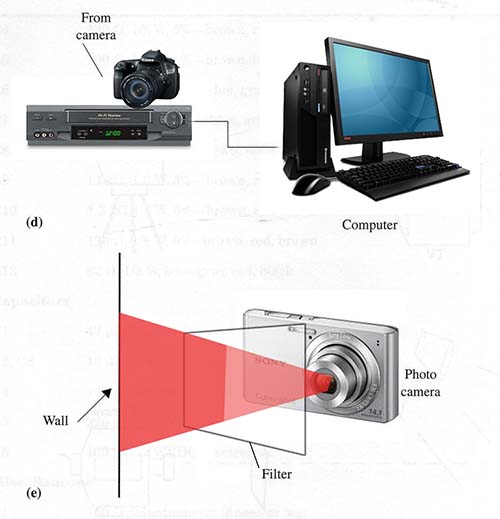Several configurations that combine VCRs, cameras, and a TV with the previously described projects can be suggested. In Fig. 1, we show some of them.


In Fig. 1a, we have the basic configuration to pick up paranormal images with a TV camera. The TV receiver tunes white noise, producing a “sparkling” image that is picked up by a camera aided by several types of filters as described before. The experimenter is free to try various types of filters.
In Fig. 1b, we show the camera pointing at a white wall that is illuminated by several types of light sources: white light, colored light, infrared, modulated light, etc. This camera can also be equipped with filters.
In Fig. 1c, we see the signal picked up by the camera being processed by a video inverter before it is sent to a TV receiver.
In Fig. 1d, the received signal is applied to a computer. The images can be edited more easily with this resource.
Fig. 1e shows the use of a photographic camera to pick up the images. The photo can be scanned and edited with a computer. Filters can be added to the experiment as in the other cases. Various light sources can be created by the experimenter.
Interpreting the Results
Hundreds of researchers from all over the world are now trying to pick up sounds and images from the next dimension-or from wherever they come. The correct configuration to find what they seek is not known. Many researchers claim to have found the solution and maintain that their equipment is the best.
Some sell equipment for hundreds or thousands of dollars (although it may not be even as sophisticated as the devices we describe here) and attempt to convince the purchaser that this equipment includes some special scientific secret.
Many photos and images are displayed in the media. For a sample, simply type “Kirlian” into any search engine on the Internet. But when paranormal equipment vendors are asked for details about the devices they are using or are invited to demonstrate and explain their operation, they become evasive, saying that their equipment involves “secret techniques” or that the principles are too difficult to explain to “common people” (possibly in an attempt to justify the high prices).
In practice, the interpretation may also vary according to the beliefs of each researcher, according to what he wants people to see in the images.
Extrapolation and radicalization of results, as in the case of EVP and EIP, is also a common occurrence. We warn the serious researcher to be very careful when interpreting the results and describing his discoveries in this fantastic field.




